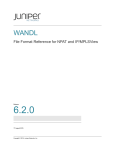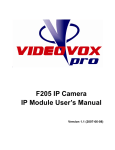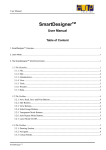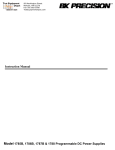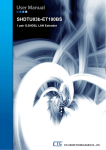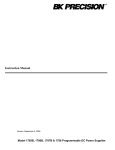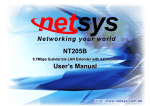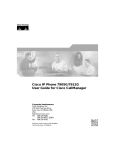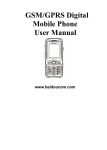Download Cisco SONET/SDH Specifications
Transcript
Cisco ONS 15454 SONET/SDH Unified
Control Plane Configuration Guide
Corporate Headquarters
Cisco Systems, Inc.
170 West Tasman Drive
San Jose, CA 95134-1706
USA
http://www.cisco.com
Tel: 408 526-4000
800 553-NETS (6387)
Fax: 408 526-4100
Text Part Number: OL-4214-01
THE SPECIFICATIONS AND INFORMATION REGARDING THE PRODUCTS IN THIS MANUAL ARE SUBJECT TO CHANGE WITHOUT NOTICE. ALL
STATEMENTS, INFORMATION, AND RECOMMENDATIONS IN THIS MANUAL ARE BELIEVED TO BE ACCURATE BUT ARE PRESENTED WITHOUT
WARRANTY OF ANY KIND, EXPRESS OR IMPLIED. USERS MUST TAKE FULL RESPONSIBILITY FOR THEIR APPLICATION OF ANY PRODUCTS.
THE SOFTWARE LICENSE AND LIMITED WARRANTY FOR THE ACCOMPANYING PRODUCT ARE SET FORTH IN THE INFORMATION PACKET THAT
SHIPPED WITH THE PRODUCT AND ARE INCORPORATED HEREIN BY THIS REFERENCE. IF YOU ARE UNABLE TO LOCATE THE SOFTWARE LICENSE
OR LIMITED WARRANTY, CONTACT YOUR CISCO REPRESENTATIVE FOR A COPY.
The following information is for FCC compliance of Class A devices: This equipment has been tested and found to comply with the limits for a Class A digital device, pursuant
to part 15 of the FCC rules. These limits are designed to provide reasonable protection against harmful interference when the equipment is operated in a commercial
environment. This equipment generates, uses, and can radiate radio-frequency energy and, if not installed and used in accordance with the instruction manual, may cause
harmful interference to radio communications. Operation of this equipment in a residential area is likely to cause harmful interference, in which case users will be required
to correct the interference at their own expense.
The following information is for FCC compliance of Class B devices: The equipment described in this manual generates and may radiate radio-frequency energy. If it is not
installed in accordance with Cisco’s installation instructions, it may cause interference with radio and television reception. This equipment has been tested and found to
comply with the limits for a Class B digital device in accordance with the specifications in part 15 of the FCC rules. These specifications are designed to provide reasonable
protection against such interference in a residential installation. However, there is no guarantee that interference will not occur in a particular installation.
Modifying the equipment without Cisco’s written authorization may result in the equipment no longer complying with FCC requirements for Class A or Class B digital
devices. In that event, your right to use the equipment may be limited by FCC regulations, and you may be required to correct any interference to radio or television
communications at your own expense.
You can determine whether your equipment is causing interference by turning it off. If the interference stops, it was probably caused by the Cisco equipment or one of its
peripheral devices. If the equipment causes interference to radio or television reception, try to correct the interference by using one or more of the following measures:
• Turn the television or radio antenna until the interference stops.
• Move the equipment to one side or the other of the television or radio.
• Move the equipment farther away from the television or radio.
• Plug the equipment into an outlet that is on a different circuit from the television or radio. (That is, make certain the equipment and the television or radio are on circuits
controlled by different circuit breakers or fuses.)
Modifications to this product not authorized by Cisco Systems, Inc. could void the FCC approval and negate your authority to operate the product.
The Cisco implementation of TCP header compression is an adaptation of a program developed by the University of California, Berkeley (UCB) as part of UCB’s public
domain version of the UNIX operating system. All rights reserved. Copyright © 1981, Regents of the University of California.
NOTWITHSTANDING ANY OTHER WARRANTY HEREIN, ALL DOCUMENT FILES AND SOFTWARE OF THESE SUPPLIERS ARE PROVIDED “AS IS” WITH
ALL FAULTS. CISCO AND THE ABOVE-NAMED SUPPLIERS DISCLAIM ALL WARRANTIES, EXPRESSED OR IMPLIED, INCLUDING, WITHOUT
LIMITATION, THOSE OF MERCHANTABILITY, FITNESS FOR A PARTICULAR PURPOSE AND NONINFRINGEMENT OR ARISING FROM A COURSE OF
DEALING, USAGE, OR TRADE PRACTICE.
IN NO EVENT SHALL CISCO OR ITS SUPPLIERS BE LIABLE FOR ANY INDIRECT, SPECIAL, CONSEQUENTIAL, OR INCIDENTAL DAMAGES, INCLUDING,
WITHOUT LIMITATION, LOST PROFITS OR LOSS OR DAMAGE TO DATA ARISING OUT OF THE USE OR INABILITY TO USE THIS MANUAL, EVEN IF CISCO
OR ITS SUPPLIERS HAVE BEEN ADVISED OF THE POSSIBILITY OF SUCH DAMAGES.
CCIP, CCSP, the Cisco Arrow logo, the Cisco Powered Network mark, the Cisco Systems Verified logo, Cisco Unity, Follow Me Browsing, FormShare, iQ Net Readiness
Scorecard, Networking Academy, and ScriptShare are trademarks of Cisco Systems, Inc.; Changing the Way We Work, Live, Play, and Learn, The Fastest Way to Increase
Your Internet Quotient, and iQuick Study are service marks of Cisco Systems, Inc.; and Aironet, ASIST, BPX, Catalyst, CCDA, CCDP, CCIE, CCNA, CCNP, Cisco, the
Cisco Certified Internetwork Expert logo, Cisco IOS, the Cisco IOS logo, Cisco Press, Cisco Systems, Cisco Systems Capital, the Cisco Systems logo, Empowering the
Internet Generation, Enterprise/Solver, EtherChannel, EtherSwitch, Fast Step, GigaStack, Internet Quotient, IOS, IP/TV, iQ Expertise, the iQ logo, LightStream, MGX,
MICA, the Networkers logo, Network Registrar, Packet, PIX, Post-Routing, Pre-Routing, RateMUX, Registrar, SlideCast, SMARTnet, StrataView Plus, Stratm, SwitchProbe,
TeleRouter, TransPath, and VCO are registered trademarks of Cisco Systems, Inc. and/or its affiliates in the U.S. and certain other countries.
All other trademarks mentioned in this document or Web site are the property of their respective owners. The use of the word partner does not imply a partnership relationship
between Cisco and any other company. (0303R)
Cisco ONS 15454 SONET/SDH Unified Control Plane Configuration Guide
Copyright © 2003 Cisco Systems, Inc. All rights reserved.
C O N T E N T S
About This Guide
v
Document Objectives
Audience
v
v
Document Organization
vi
Related Documentation
vi
Document Conventions
vii
Where to Find Safety and Warning Information
viii
Obtaining Documentation viii
Cisco.com viii
Documentation CD-ROM viii
Ordering Documentation viii
Documentation Feedback ix
Obtaining Technical Assistance ix
Cisco.com ix
Technical Assistance Center ix
Obtaining Additional Publications and Information
xi
xi
CHAPTER
1
Overview
1-1
1.1 Understanding UCP
1-1
1.2 UNI Implementation 1-1
Client and Network Roles 1-2
Adjacent Node Communication 1-2
Port Addressing 1-3
Inter-Domain Circuits 1-3
CHAPTER
2
User Control Plane Configuration
2-1
2.1 Configure an ONS 15454 as User Network Interface–Client (UNI-C) Node
2.2 Create an Inter-Domain Circuit
2-4
2.3 Create a UCP-Signaled Circuit
2-4
2.4 Change a Neighbor Configuration
2.5 Change an IPCC Configuration
2-1
2-5
2-6
2.6 Change a UCP Interface Configuration
2-6
Cisco ONS 15454 SONET/SDH Unified Control Plane Configuration Guide
OL-4214-01
iii
Contents
2.7 Delete a Neighbor, IPCC, Interface, or UCP-Signaled Circuit
CHAPTER
3
Alarm Troubleshooting
3.1 UCP Alarms
2-6
3-1
3-1
3.2 UCP Conditions
3-2
Cisco ONS 15454 SONET/SDH Unified Control Plane Configuration Guide
iv
OL-4214-01
About This Guide
This section explains the objectives, intended audience, and organization of this publication and
describes the conventions that convey instructions and other information.
This section provides the following information:
•
Document Objectives
•
Audience
•
Document Organization
•
Related Documentation
•
Document Conventions
•
Where to Find Safety and Warning Information
•
Obtaining Documentation
•
Obtaining Technical Assistance
•
Obtaining Additional Publications and Information
Document Objectives
This guide explains unified control plane (UCP) concepts, provisioning, and troubleshooting for the
Cisco ONS 15454 SONET and SDH systems. Before using this guide, you must test the interoperability
of the ONS 15454 SONET and SDH nodes and third-party vendor nodes in the network.
Use this guide with the appropriate publications listed in the Related Documentation section.
Audience
To use this guide, you should be familiar with Cisco or equivalent optical transmission hardware and
cabling, telecommunications hardware and cabling, electronic circuitry and wiring practices, and
preferably have experience as a telecommunications technician.
Cisco ONS 15454 SONET/SDH Unified Control Plane Configuration Guide
OL-4214-01
v
About This Guide
Document Organization
Document Organization
This Cisco ONS 15454 SONET/SDH Unified Control Plane Configuration Guide is organized into the
following chapters:
•
Chapter 1, “Overview” provides an introduction to the Unified Control Plane (UCP).
•
Chapter 2, “User Control Plane Configuration” provides procedures for setting up an ONS 15454
node to transport circuits in a UCP implementation.
•
Chapter 3, “Alarm Troubleshooting” provides general troubleshooting procedures as well as a
description of UCP alarms.
Related Documentation
Use this Cisco ONS 15454 SONET/SDH Unified Control Plane Configuration Guide with the following
referenced publications:
•
Cisco ONS 15454 Procedure Guide
•
Cisco ONS 15454 Reference Manual
•
Cisco ONS 15454 Troubleshooting Guide
•
Cisco ONS 15454 SDH Procedure Guide
•
Cisco ONS 15454 SDH Reference Manual
•
Cisco ONS 15454 SDH Troubleshooting Guide
Refer to the following standards documentation referenced in this publication:
•
Optical Internetworking Forum (OIF) UNI signaling specification, User Network Interface (UNI)
1.0 Signaling Specification OIF Architecture, OAM&P, PLL, and Signaling Working Groups,
OIF 2000.125.7
Cisco ONS 15454 SONET/SDH Unified Control Plane Configuration Guide
vi
OL-4214-01
About This Guide
Document Conventions
Document Conventions
This publication uses the following conventions:
Convention
Application
boldface
Commands and keywords in body text.
italic
Command input that is supplied by the user.
[
Keywords or arguments that appear within square brackets are optional.
]
{x|x|x}
A choice of keywords (represented by x) appears in braces separated by
vertical bars. The user must select one.
Ctrl
The control key. For example, where Ctrl + D is written, hold down the
Control key while pressing the D key.
screen font
Examples of information displayed on the screen.
boldface screen font
Examples of information that the user must enter.
<
Command parameters that must be replaced by module-specific codes.
>
Note
Means reader take note. Notes contain helpful suggestions or references to material not covered in
the document.
Caution
Means reader be careful. In this situation, the user might do something that could result in equipment
damage or loss of data.
Warning
IMPORTANT SAFETY INSTRUCTIONS
This warning symbol means danger. You are in a situation that could cause bodily injury. Before you
work on any equipment, be aware of the hazards involved with electrical circuitry and be familiar
with standard practices for preventing accidents. To see translations of the warnings that appear in
this publication, refer to the translated safety warnings that accompanied this device.
Note: SAVE THESE INSTRUCTIONS
Note: This documentation is to be used in conjunction with the specific product installation guide
that shipped with the product. Please refer to the Installation Guide, Configuration Guide, or other
enclosed additional documentation for further details.
Cisco ONS 15454 SONET/SDH Unified Control Plane Configuration Guide
OL-4214-01
vii
About This Guide
Where to Find Safety and Warning Information
Where to Find Safety and Warning Information
For safety and warning information, refer to the Cisco ONS 15454 Installation Handbook that
accompanied the product. This publication describes the international agency compliance and safety
information for the Cisco ONS 15454. It also includes translations of the safety warnings that appear in
the ONS 15454 documentation.
Obtaining Documentation
Cisco provides several ways to obtain documentation, technical assistance, and other technical
resources. These sections explain how to obtain technical information from Cisco Systems.
Cisco.com
You can access the most current Cisco documentation on the World Wide Web at this URL:
http://www.cisco.com/univercd/home/home.htm
You can access the Cisco website at this URL:
http://www.cisco.com
International Cisco websites can be accessed from this URL:
http://www.cisco.com/public/countries_languages.shtml
Documentation CD-ROM
Optical networking-related documentation is available in a CD-ROM package that ships with your
product. The Optical Networking Product Documentation CD-ROM is updated periodically and may be
more current than printed documentation.
Ordering Documentation
You can find instructions for ordering documentation at this URL:
http://www.cisco.com/univercd/cc/td/doc/es_inpck/pdi.htm
You can order Cisco documentation in these ways:
•
Registered Cisco.com users (Cisco direct customers) can order Cisco product documentation from
the Networking Products MarketPlace:
http://www.cisco.com/en/US/partner/ordering/index.shtml
•
Nonregistered Cisco.com users can order documentation through a local account representative by
calling Cisco Systems Corporate Headquarters (California, U.S.A.) at 408 526-7208 or, elsewhere
in North America, by calling 800 553-NETS (6387).
Cisco ONS 15454 SONET/SDH Unified Control Plane Configuration Guide
viii
OL-4214-01
About This Guide
Obtaining Technical Assistance
Documentation Feedback
You can submit comments electronically on Cisco.com. On the Cisco Documentation home page, click
Feedback at the top of the page.
You can e-mail your comments to [email protected].
You can submit comments by using the response card (if present) behind the front cover of your
document or by writing to the following address:
Cisco Systems
Attn: Customer Document Ordering
170 West Tasman Drive
San Jose, CA 95134-9883
We appreciate your comments.
Obtaining Technical Assistance
Cisco provides Cisco.com, which includes the Cisco Technical Assistance Center (TAC) website, as a
starting point for all technical assistance. Customers and partners can obtain online documentation,
troubleshooting tips, and sample configurations from the Cisco TAC website. Cisco.com registered users
have complete access to the technical support resources on the Cisco TAC website, including TAC tools
and utilities.
Cisco.com
Cisco.com offers a suite of interactive, networked services that let you access Cisco information,
networking solutions, services, programs, and resources at any time, from anywhere in the world.
Cisco.com provides a broad range of features and services to help you with these tasks:
•
Streamline business processes and improve productivity
•
Resolve technical issues with online support
•
Download and test software packages
•
Order Cisco learning materials and merchandise
•
Register for online skill assessment, training, and certification programs
To obtain customized information and service, you can self-register on Cisco.com at this URL:
http://tools.cisco.com/RPF/register/register.do
Technical Assistance Center
The Cisco TAC is available to all customers who need technical assistance with a Cisco product,
technology, or solution. Two types of support are available: the Cisco TAC website and the Cisco TAC
Escalation Center. The type of support that you choose depends on the priority of the problem and the
conditions stated in service contracts, when applicable.
Cisco ONS 15454 SONET/SDH Unified Control Plane Configuration Guide
OL-4214-01
ix
About This Guide
Obtaining Technical Assistance
We categorize Cisco TAC inquiries according to urgency:
•
Priority level 4 (P4)—You need information or assistance concerning Cisco product capabilities,
product installation, or basic product configuration. There is little or no impact to your business
operations.
•
Priority level 3 (P3)—Operational performance of the network is impaired, but most business
operations remain functional. You and Cisco are willing to commit resources during normal business
hours to restore service to satisfactory levels.
•
Priority level 2 (P2)—Operation of an existing network is severely degraded, or significant aspects
of your business operations are negatively impacted by inadequate performance of Cisco products.
You and Cisco will commit full-time resources during normal business hours to resolve the situation.
•
Priority level 1 (P1)—An existing network is “down,” or there is a critical impact to your business
operations. You and Cisco will commit all necessary resources around the clock to resolve the
situation.
Cisco TAC Website
The Cisco TAC website provides online documents and tools to help troubleshoot and resolve technical
issues with Cisco products and technologies. To access the Cisco TAC website, go to this URL:
http://www.cisco.com/tac
All customers, partners, and resellers who have a valid Cisco service contract have complete access to
the technical support resources on the Cisco TAC website. Some services on the Cisco TAC website
require a Cisco.com login ID and password. If you have a valid service contract but do not have a login
ID or password, go to this URL to register:
http://tools.cisco.com/RPF/register/register.do
If you are a Cisco.com registered user, and you cannot resolve your technical issues by using the Cisco
TAC website, you can open a case online at this URL:
http://www.cisco.com/tac/caseopen
If you have Internet access, we recommend that you open P3 and P4 cases online so that you can fully
describe the situation and attach any necessary files.
Cisco TAC Escalation Center
The Cisco TAC Escalation Center addresses priority level 1 or priority level 2 issues. These
classifications are assigned when severe network degradation significantly impacts business operations.
When you contact the TAC Escalation Center with a P1 or P2 problem, a Cisco TAC engineer
automatically opens a case.
To obtain a directory of toll-free Cisco TAC telephone numbers for your country, go to this URL:
http://www.cisco.com/warp/public/687/Directory/DirTAC.shtml
Before calling, please check with your network operations center to determine the Cisco support services
to which your company is entitled: for example, SMARTnet, SMARTnet Onsite, or Network Supported
Accounts (NSA). When you call the center, please have available your service agreement number and
your product serial number.
Cisco ONS 15454 SONET/SDH Unified Control Plane Configuration Guide
x
OL-4214-01
About This Guide
Obtaining Additional Publications and Information
Obtaining Additional Publications and Information
Information about Cisco products, technologies, and network solutions is available from various online
and printed sources.
•
The Cisco Product Catalog describes the networking products offered by Cisco Systems, as well as
ordering and customer support services. Access the Cisco Product Catalog at this URL:
http://www.cisco.com/en/US/products/products_catalog_links_launch.html
•
Cisco Press publishes a wide range of networking publications. Cisco suggests these titles for new
and experienced users: Internetworking Terms and Acronyms Dictionary, Internetworking
Technology Handbook, Internetworking Troubleshooting Guide, and the Internetworking Design
Guide. For current Cisco Press titles and other information, go to Cisco Press online at this URL:
http://www.ciscopress.com
•
Packet magazine is the Cisco quarterly publication that provides the latest networking trends,
technology breakthroughs, and Cisco products and solutions to help industry professionals get the
most from their networking investment. Included are networking deployment and troubleshooting
tips, configuration examples, customer case studies, tutorials and training, certification information,
and links to numerous in-depth online resources. You can access Packet magazine at this URL:
http://www.cisco.com/go/packet
•
iQ Magazine is the Cisco bimonthly publication that delivers the latest information about Internet
business strategies for executives. You can access iQ Magazine at this URL:
http://www.cisco.com/go/iqmagazine
•
Internet Protocol Journal is a quarterly journal published by Cisco Systems for engineering
professionals involved in designing, developing, and operating public and private internets and
intranets. You can access the Internet Protocol Journal at this URL:
http://www.cisco.com/en/US/about/ac123/ac147/about_cisco_the_internet_protocol_journal.html
•
Training—Cisco offers world-class networking training. Current offerings in network training are
listed at this URL:
http://www.cisco.com/en/US/learning/le31/learning_recommended_training_list.html
Cisco ONS 15454 SONET/SDH Unified Control Plane Configuration Guide
OL-4214-01
xi
About This Guide
Cisco ONS 15454 SONET/SDH Unified Control Plane Configuration Guide
xii
OL-4214-01
C H A P T E R
1
Overview
This chapter provides an overview of the unified control plane (UCP) and the user-network interface
(UNI) implementations, supported by the ONS 15454 SONET and SDH systems. Cisco Transport
Controller (CTC) releases 3.4 and later support UCP.
This chapter contains the following sections:
•
1.1 Understanding UCP, page 1-1
•
1.2 UNI Implementation, page 1-1
1.1 Understanding UCP
UCP is a software feature released for Cisco ONS 15454 SONET and SDH Releases 3.4 and later. It
provides a service architecture that can manage and provision network elements (NEs) using a single
management layer. For example, UCP allows a user to perform “A to Z” provisioning outside of an
ONS 15454 section data communications channel (SDCC)-connected network without a higher-layer
management system to communicate between subnetworks. The network infrastructure can include
assorted NEs such as routers, Layer 2 (L2) and Layer 3 (L3) switches, SONET and SDH optical
products, optical cross-connects, and wavelength routers.
UCP comprises two major interface types, a user-network interface (UNI) and a network-network
interface (NNI). Both UNI and NNI are optical interfaces. UNI conforms to the Optical Internetworking
Forum (OIF) UNI 1.0 standards. It provides data client services, rapid provisioning of SONET and SDH
circuits through an optical internetwork, and signaling between a client device and a transport network
element. NNI exchanges signals and routing data between NEs in a network. The difference between
UNI and NNI is that UNI does not support the exchange of routing information (such as topology data)
across the interface. The ONS 15454 SONET and SDH systems do not support NNI configuration.
1.2 UNI Implementation
This section describes the client and network roles, communication between adjacent nodes, port
addressing requirements, and inter-domain circuits in a UNI implementation. The Cisco Transport
Controller (CTC) is the network management tool used for UNI provisioning. All circuit capabilities
supported in the ONS 15454 SONET and SDH Release 3.4 and later are available for UCP circuit
provisioning.
Cisco ONS 15454 SONET/SDH Unified Control Plane Configuration Guide
OL-4214-01
1-1
Chapter 1
Overview
1.2UNI Implementation
Client and Network Roles
UNI is divided into client (UNI-C) and network (UNI-N) roles. A UNI-C network element requests and
accepts circuit provisioning information. A UNI-N network element is the node adjacent to the UNI-C
node and accepts and transports circuit provisioning information across the core network. For UNI
circuit provisioning, the network must meet the following requirements:
•
An NE must be configured in as UNI-C and connected to a UNI-N NE. Normally, the UNI-C NE is
a border NE in the client network.
•
An NE must be configured as UNI-N and connected to a UNI-C NE. Normally, the UNI-C NE is a
border NE in the core network.
The ONS 15454 SONET and SDH Releases 3.4 and 4.0 support UNI-C provisioning.
Figure 1-1 shows the position of the ONS 15454 (either SONET or SDH) in a customer network
environment. In this example, Node 4 can request Node 9 as a circuit destination. Node 5 handles the
signal and establishes a circuit through the metro core. The ONS 15454 networks on either side of the
core network are aware only that they are connected to the core at Node 5 and Node 8, respectively.
Note
Figure 1-1
Nodes 5 and 8 must support the UNI-N feature for UNI-C on the ONS 15454 to work.
UNI-C Nodes Connected to the Core Network
Node 2
Node 10
Metro Core
Node 6
ONE
Node 1
Node 4
ONS 15454
Network
Node 5
ONE
Node 8
Core Network
Node 9
Node 12
ONS 15454
Network
ONE
UNI-C
Node 3
UNI-N
Node 7
UNI-N
UNI-C
Node 11
90614
ONE
Adjacent Node Communication
Adjacent UNI-C and UNI-N NEs, called “neighbors,” communicate over a control channel. A control
channel is a logical channel between two neighbors that have one or more links capable of carrying data.
Link management protocol (LMP) establishes and maintains control channel connectivity between
neighbors. LMP also enables neighbor discovery, which allows neighbors to identify connected devices;
obtain UNI connectivity information; and identify and verify port-level connections, network-level
addresses, and corresponding operational states for every link.
Each control channel has a unique 16-bit identification number, called a CCID. Each end of a control
channel requires a local IP version 4 (IPv4) or IP version 6 (IPv6) control channel (IPCC) address. By
default, this address is the internal address of each neighbor, but can be a different address.
Cisco ONS 15454 SONET/SDH Unified Control Plane Configuration Guide
1-2
OL-4214-01
Chapter 1
Overview
1.2UNI Implementation
Control channels can be in-fiber/in-band (IF/IB), which means that the control channel uses the same
physical link as the data link that controls it or out-of-fiber/out-of-band (OF/OB), which means that the
control channel uses a different physical path than the data links it controls. IF/IB, also called SDCC
IPCC, is transported over the embedded SONET/SDH SDCC bytes between the client and the network
interface. OF/OB, also called routed IPCC, is transported over the 10/100T Ethernet interface.
Port Addressing
Each UNI-C NE must have a port configured for UCP implementation. This port is called an interface
or datalink. Each port in a UNI-C connection must have an identifier called a transport network address
(TNA). A TNA can be in IPv4, IPv6, or network service access point (NSAP) format.
Inter-Domain Circuits
An inter-domain circuit (IDC) is an end-to-end circuit that can contain both UCP-signaled and
non-signaled circuits. A UCP-signaled circuit is a circuit routed across the core network; it originates at
a UNI-C interface in one network and terminates at another UNI-C interface in another network.
Resource ReSerVation Protocol (RSVP) is protocol originally designed to request specific qualities of
service (QoS) from the network for particular application data streams or flows. RSVP can now provide
a signal for SONET/SDH circuits. The control channel transports these RSVP messages, which carry
source and destination addresses and required circuit attributes, such as bandwidth, framing type
(SONET or SDH), connection diversity, and service level.
A non-signaled circuit is a circuit within a subnetwork; it is not routed across the core network.
The ONS 15454 SONET and SDH Release 3.4 and 4.0 UNI implementation supports signaling over
optical interfaces. The supported circuits sizes for the UNI-C interface are STS-1, STS-3c/STM-1,
STS-6c, STS-9c, STS-12c/STM-4, STS-24c, STS-48c/STM-16, STS-192c/STM-64.
Figure 1-2 shows an example of an inter-domain circuit. You can create inter-domain circuits on the CTC
Circuits tab in network view.
Figure 1-2
Inter-Domain Circuit
Node 2
Node 10
Metro Core
Node 6
ONE
Node 1
Node 4
ONS 15454
Network
Node 5
ONE
Node 8
Core Network
Node 9
Node 12
ONS 15454
Network
ONE
UNI-C
Node 3
Non-signaled segment
in source subnetwork
UNI-N
Node 7
Signaled segment
UNI-N
90651
ONE
UNI-C
Node 11
Non-signaled segment
in destination subnetwork
Cisco ONS 15454 SONET/SDH Unified Control Plane Configuration Guide
OL-4214-01
1-3
Chapter 1
Overview
1.2UNI Implementation
Cisco ONS 15454 SONET/SDH Unified Control Plane Configuration Guide
1-4
OL-4214-01
C H A P T E R
2
User Control Plane Configuration
This chapter explains the Cisco Transport Controller (CTC) operation for configuring circuits across a
core network. The chapter procedures follow:
1.
2.1 Configure an ONS 15454 as User Network Interface–Client (UNI-C) Node, page 2-1—Complete
this procedure first. This procedure sets up two ONS 15454 SONET or SDH nodes as UNI-C nodes.
2.
2.2 Create an Inter-Domain Circuit, page 2-4—Complete this procedure to create an inter-domain
(IDC) circuit over the core network.
3.
2.3 Create a UCP-Signaled Circuit, page 2-4—Complete this procedure to create a UCP-signaled
circuit, which originates at a UNI-C interface in one network and terminates at another UNI-C
interface in another network. This procedure is not necessary if you used CTC to create an IDC
circuit.
4.
2.4 Change a Neighbor Configuration, page 2-5—Complete this procedure as needed to edit a
neighbor.
5.
2.5 Change an IPCC Configuration, page 2-6—Complete this procedure as needed to edit an IPCC.
6.
2.6 Change a UCP Interface Configuration, page 2-6—Complete this procedure as needed to edit an
interface.
7.
2.7 Delete a Neighbor, IPCC, Interface, or UCP-Signaled Circuit, page 2-6—Complete this
procedure as needed to remove a neighbor, IPCC, interface, or user control plane (UCP)-signaled
circuit.
2.1 Configure an ONS 15454 as User Network Interface–Client
(UNI-C) Node
Use this procedure to configure an ONS 15454 SONET or SDH node as UNI-C and connect it to a core
network.
Step 1
Log onto a node that you want to configure as UNI-C.
Step 2
At the node view, click the Provisioning > UCP tabs (Figure 2-1).
Cisco ONS 15454 SONET/SDH Unified Control Plane Configuration Guide
OL-4214-01
2-1
Chapter 2
User Control Plane Configuration
2.1Configure an ONS 15454 as User Network Interface–Client (UNI-C) Node
Figure 2-1
Step 3
UCP Tab
On the Node tab, verify the node-level UCP parameters, and edit as necessary:
•
UCP Node ID—Node IP address
•
Initial Interval—Initial retry interval for circuits released by the network (60 to 1800 seconds)
•
Max. Interval—Maximum retry interval (180 to 1800 seconds; must be greater than the Circuit Retry
Initial Interval)
•
Restart Time—Time required for the node to restart (60 to 300 seconds); signaled to neighbors
•
Re-transmit Interval—Interval for retransmitting unacknowledged messages (1 to 7 seconds)
•
Recovery Time—Time required by the node to resynchronize the path and reservation states with a
neighbor (300 to 1800 seconds); signaled to neighbors
•
Refresh Interval—Interval for refreshing path and reservation states (30 to 4660800 seconds)
•
RESV—Timeout interval while waiting for the reservation request (RESV) message (10 to 180
seconds; a connection is established when the initiating node receives a RESV message for the
connection
•
RESV CONF—Timeout interval while waiting for the reservation confirmation (RESV CONF)
message (10 to 180 seconds; the RESV CONF acknowledges receipt of the RESV message
•
Source Deletion in Progress—Timeout interval while the source node is cleanly deleting a call (10
to 180 seconds)
•
Destination Deletion in Progress—Timeout interval while the destination node is cleanly deleting a
call (10 to 180 seconds)
Step 4
Click the UCP Provisioning button to start the Provision UCP wizard.
Step 5
On the Existing Neighbors list, choose the neighbor for which you want to set up the IP control channel
(IPCC) and continue with Step 6. To create a neighbor, click Create on the Unified Control Plane
Provisioning dialog box. In the Create a New Neighbor dialog box, complete the following fields and
click OK:
•
Neighbor Name—Type a neighbor name in the field (a maximum of 64 alphanumeric characters).
•
Neighbor Discovery—To enable automatic neighbor discovery, check the check box. If you do not
check the Neighbor Discovery check box, type the IP address of the neighbor in the Node ID field.
•
Hello—To enable RSVP hello, check the check box and choose the hello interval from the
drop-down list.
Cisco ONS 15454 SONET/SDH Unified Control Plane Configuration Guide
2-2
OL-4214-01
Chapter 2
User Control Plane Configuration
2.1Configure an ONS 15454 as User Network Interface–Client (UNI-C) Node
•
Refresh Reduction—Check the check box to reduce the processing overhead requirements of refresh
messages.
•
Max # of retransmits—Choose the maximum number of times (2 to 5) that unacknowledged
messages will be transmitted.
Step 6
Click Next. The IPCC dialog box appears.
Step 7
Complete one of the following:
•
To use an existing IPCC, choose an IPCC from the Existing IPCCs list or check Use Any IPCC. If
you check Use Any IPCC, CTC automatically selects an SDCC IPCC or routed IPCC. Continue with
Step 9.
•
To create a new IPCC, click Create. In the Create New IPCC dialog box, complete the following
fields and click OK:
– IPCC Type—Click Routed for out-of-band signaling, or SDCC for in-band signaling.
– SDCC—If the IPCC type is SDCC, choose a slot/port from the SDCC list (this list is disabled
if the IPCC type is Routed). If the IPCC type is routed, this option is not available.
– Local IPCC—Type the IP address (the node IP address is the default).
– Remote IPCC—If the IPCC type is Routed, type the IP address. If the IPCC type is SDCC, this
option is not available.
– LMP Hello Interval—Choose the time interval between link management protocol (LMP) hello
messages sent for this control channel.
– LMP Hello Dead IntervaI—Choose the time interval that the neighbor will wait before timing
out a control channel if no LMP hello message is received. This interval must be at least three
times the LMP Hello Interval value.
– MTU—If the IPCC type is SDCC, type the maximum transmission unit for point-to-point
protocol (PPP) frames. If the IPCC type is routed, this option is not available.
– CRC—If the IPCC type is SDCC, choose the cyclic redundancy code (16- or 32- bit) for
point-to-point protocol (PPP) frames. If the IPCC type is routed, this option is not available.
– Port State—If the IPCC type is SDCC, click Set to IS to place the port in service. If the IPCC
type is routed, this option is not available.
Step 8
From the Existing IPCCs list, choose an IPCC.
Step 9
Click Next. The UCP Interface Attributes dialog box appears.
Step 10
On the UCP Interface Attributes dialog box, complete the following fields to set the UNI-C interface
attributes:
•
UCP Interface—Choose the slot/port from the drop-down list. If the IPCC type is SDCC, the IPCC
is the same slot/port as the UCP interface.
•
Local Interface ID—If the IPCC type is Routed, type the local node ID. (This field is disabled if the
IPCC type is SDCC.)
•
Remote Interface ID—If the IPCC type is Routed, type the neighbor interface ID in the Remote
Interface ID field. (This field is disabled when Neighbor Discovery is enabled.)
•
Core Network ID—Type a numerical identifier (1 through 255) to identify the core transport
network.
•
TNA Address—Choose the transport network address (TNA) interface:
– IP version 4—A unique 32-bit identifier used to address hosts on the Internet
– IP version 6—The “next generation” protocol designed by the IETF to replace IPv4
Cisco ONS 15454 SONET/SDH Unified Control Plane Configuration Guide
OL-4214-01
2-3
Chapter 2
User Control Plane Configuration
2.2Create an Inter-Domain Circuit
– NSAP—Network service access point
Step 11
Click Finish. A message appears asking you to verify that the local ID on this node matches the remote
ID at the neighboring node. Click OK.
Note
CTC will not automatically discover the neighbor and IPCC until you set up a second UNI
interface.
Step 12
Repeat Steps 2 through 11 to create the connecting UNI-C interface on the other side of the core network.
Note
The Neighbor, IPCC, and Interface subtabs all include Create buttons. Clicking the Create button on any
of these subtabs will launch the UCP Provisioning wizard. A neighbor must exist before you can create
an IPCC, and an IPCC must exist before you can create an interface.
2.2 Create an Inter-Domain Circuit
An inter-domain circuit (IDC), or end-to-end, circuit includes both UCP-signaled and non-signaled
circuits. Before you create an end-to-end IDC circuit, you must complete the “Configure an ONS 15454
as User Network Interface–Client (UNI-C) Node” section on page 2-1 to set up a UNI-C network
element on each side of the core network. If one end of a UCP-signaled segment is an ONS 15454
SONET or SDH node and the other end is supplied and managed by another vendor, see the “Create a
UCP-Signaled Circuit” section on page 2-4.
Step 1
In node or network view, click the Circuits tab.
Step 2
Use the circuit wizard to create a circuit. For specific procedures about circuit creation, refer to the
Release 3.4 or later Cisco ONS 15454 Procedure Guide or the Cisco ONS 15454 SDH Procedure Guide.
2.3 Create a UCP-Signaled Circuit
If one end of a UCP-signaled segment is an ONS 15454 SONET or SDH node and the other end is
supplied and managed by another vendor, you must use this procedure to set up the UCP-signaled circuit
across the core network.
Before beginning this procedure, you must complete the “Configure an ONS 15454 as User Network
Interface–Client (UNI-C) Node” section on page 2-1 to set up a UNI-C network element on each side of
the core network.
Step 1
At the node view, click the Provisioning > UCP > Circuits tabs.
Step 2
On the Circuits subtab, click Create. The New UCP Signaled Circuit dialog box appears.
Step 3
Complete the following fields and click OK:
•
UCP Circuit Node—Click Origin to set the circuit as the originating UNI-C or click Termination
to set the circuit as the terminating UNI-C.
Cisco ONS 15454 SONET/SDH Unified Control Plane Configuration Guide
2-4
OL-4214-01
Chapter 2
User Control Plane Configuration
2.4Change a Neighbor Configuration
•
Data Link—Choose the interface from the drop-down list.
•
Circuit Size—Choose the circuit size from the drop-down list.
•
STS—Choose the STS number from the drop-down list.
•
Termination TNA Address—Choose the transport network address (TNA) format (IPv4, IPv6, or
NSAP), and type the IP address of the endpoint node.
•
Destination Egress Label—If you selected Origin, type the destination interface ID and STS/STM
information. The Destination Egress Label is used by the destination UNI-N to determine which port
and STS number to include in the destination UNI-N to UNI-C message.
•
Service Level—If you selected Origin, type the service level to indicate the service needed for the
circuit from the core network (0 through 255). Each service level corresponds to carrier predefined
characteristics, such as type of restoration (unprotected, 1+1 protection, etc.), connection setup and
hold priorities, reversion strategies for the connection after failures have been repaired, and retention
strategies.
•
G-PID—If you selected Origin, type the generic payload identifier (G-PID) to identify the client
layer of the connection (0 through 255).
Note
Step 4
G-PID values are listed in IETF RFC 3471, Generalized Multi-Protocol Label Switching
(GMPLS) Signaling Functional Description.
Click OK.
2.4 Change a Neighbor Configuration
The UCP > Neighbor tab lists the existing neighbors. Use the following procedure to change the
neighbor configuration.
Step 1
At node view, click the Provisioning > UCP > Neighbor tabs.
Step 2
On the Neighbor subtab, edit the following fields as necessary:
Step 3
•
Name
•
Hello
•
Hello Int
•
Refresh Reduct
Click Apply.
Cisco ONS 15454 SONET/SDH Unified Control Plane Configuration Guide
OL-4214-01
2-5
Chapter 2
User Control Plane Configuration
2.5Change an IPCC Configuration
2.5 Change an IPCC Configuration
The UCP > IPCC tab lists the existing IPCCs. Use the following procedure to change an IPCC
configuration.
Step 1
At node view, click the Provisioning > UCP > IPCC tabs.
Step 2
On the IPCC subtab, edit the following fields as necessary:
Step 3
•
Local IPCC
•
LMP Hello Integer
•
LMP Hello Dead Integer
•
MTU
•
CRC Mode
Click Apply.
2.6 Change a UCP Interface Configuration
The UCP > Interface tab lists the existing interfaces. Use the following procedure to change an interface
configuration.
Note
If a circuit exists, you cannot edit the Interface fields.
Step 1
At node view, click the Provisioning > UCP > Interface tabs.
Step 2
On the Interface subtab, edit the following fields as necessary:
Step 3
•
TNA Type
•
TNA Address
•
Core ID
Click Apply.
2.7 Delete a Neighbor, IPCC, Interface, or UCP-Signaled Circuit
The Neighbor, IPCC, Interface, and Circuit subtabs all include Delete buttons. You must delete in the
following order:
•
If a neighbor has an associated IPCC, you must delete the IPCC before CTC allows you to delete
the neighbor.
•
If an IPCC has an associated interface, you must delete the interface before CTC allows you to delete
the IPCC.
Cisco ONS 15454 SONET/SDH Unified Control Plane Configuration Guide
2-6
OL-4214-01
Chapter 2
User Control Plane Configuration
2.7Delete a Neighbor, IPCC, Interface, or UCP-Signaled Circuit
•
If an interface is used in a UCP-signaled circuit, you must delete the circuit before CTC allows you
to delete the interface.
Step 1
At node view, click the Provisioning > UCP tabs.
Step 2
Click the desired subtab (Neighbor, IPCC, Interface, or Circuit).
Step 3
Choose the neighbor, IPCC, interface, or circuit that you want to delete.
Step 4
Click the Delete button. To delete multiple neighbors, IPCCs, interfaces, or circuits, press Ctrl + Delete
simultaneously.
Step 5
At the confirmation dialog box, click Yes.
Cisco ONS 15454 SONET/SDH Unified Control Plane Configuration Guide
OL-4214-01
2-7
Chapter 2
User Control Plane Configuration
2.7Delete a Neighbor, IPCC, Interface, or UCP-Signaled Circuit
Cisco ONS 15454 SONET/SDH Unified Control Plane Configuration Guide
2-8
OL-4214-01
C H A P T E R
3
Alarm Troubleshooting
This chapter describes the alarms and conditions associated with the unified control plane (UCP). For
procedures that clear UCP alarms, refer to Release 3.4 or later of the Cisco ONS 15454 Troubleshooting
Guide or the Cisco ONS 15454 SDH Troubleshooting Guide.
3.1 UCP Alarms
Table 3-1 lists the UCP alarms.
Table 3-1
Alarm Descriptions
Alarm
Severity
Description
CKTDOWN
Critical
Service affecting
The UCP Circuit Down alarm applies to logical circuits created within the
UCP between devices. It occurs when a signaling failure occurs across a
UCP interface. The failure can be caused by a number of things, such as
failure to route the call within the core network. In that case, the alarm
cannot be resolved from the ONS 15454 because the node serves as an edge
device.
RSVP-HELLODOWN
Minor
The RSVP Hello Down alarm occurs when the hello protocol, which
Non-service affecting monitors UCP control channel status, is not available for reserving
resources. The lack of availability can be caused by misconfiguration or loss
of connectivity between the reporting node and its neighbor.
LMP-HELLODOWN
Minor
The LMP Hello Down alarm occurs when the hello protocol, which
Non-service affecting monitors UCP control channel status, is not available for link management.
Unavailability can be caused by physical layer errors (such as cabling) or by
control channel misconfiguration.
LMP-NDFAIL
Minor
The LMP Neighbor Detection Fail alarm occurs when neighbor detection
Non-service affecting within the UCP has failed. LMP-NDFAIL can be caused by physical failure
(such as cabling) between the neighbors or by control channel
misconfiguration.
Cisco ONS 15454 SONET/SDH Unified Control Plane Configuration Guide
OL-4214-01
3-1
Chapter 3
Alarm Troubleshooting
3.2UCP Conditions
3.2 UCP Conditions
Table 3-2 lists the UCP alarm conditions.
Table 3-2
Alarm Conditions
Condition
Raised When...
Cleared When...
UCP_CKT_DOWN
A provisioned circuit is temporarily or
permanently down
The circuit becomes available.
UCP_NBR_DOWN
The Resource Reservation Protocol (RSVP)
The RSVP hello procedure declares that the
hello procedure indicates that a neighbor is down neighbor is available.
UCP_CC_DOWN
The link management protocol (LMP) hello
procedure indicates that the control channel is
down
The LMP hello procedure indicates that the
control channel is available.
UCP_ND_FAILED
The LMP neighbor discovery procedure fails
The control channel resets and the neighbor
discovery procedure completes.
UCP_UNAUTH_CKTREQ
A node receives an unauthorized signaling
request
This condition is not cleared (transient
event).
Cisco ONS 15454 SONET/SDH Unified Control Plane Configuration Guide
3-2
OL-4214-01


























